There's a huge number of edible plants for the adventurous gardener to explore. While the choice may seem overwhelming at times, things are simplified by the fact that even seemingly different veggies can belong to the same family group.
Knowing about these families can make veggie-growing much easier. Although every plant variety has its own needs, members of the same family can often be cared for in similar ways. Once you've had success in growing one variety, your experience can often be transferred to its relatives with little extra effort.
Even if you've never grown a particular species before, when you know its family characteristics you'll have a better idea about which conditions it prefers, which time of year it should be planted, and how quickly you can expect it to grow. Knowing about plant families can also help you recognise seeds from their shape and size, and you'll have a good idea whether they should be sown direct or raised as seedlings under cover.
Sorting your veggies by family group also helps you plan an effective crop rotation scheme, reducing the buildup of disease that's common when the same plant types are grown in the same place each year.
And lastly, if you're planning to save seeds from one year to the next, in most cases you’ll need to avoid growing closely related plants near to each other. Growing members of the same family close together risks them cross-pollinating, leading to unpredictable results in the next generation.
What Exactly Is a Plant Family?
The word 'family' can be used in two ways. There's the botanical definition, which is used in plant classification to describe fairly wide groups of plants with similar characteristics. You can usually recognise these technical groupings by the use of a Latin name.
However, 'family' is also used in a much looser sense, where strict botanical rules aren't necessarily followed, and the names are more often English words. For example, the brassica and cabbage families are both used by vegetable gardeners to refer to much the same group of plants, and while there may be technical differences, in practical terms they mean the same thing.
The Most Important Plant Families for Vegetable Growers
For home-grown vegetables, members of the following five families are the ones most commonly grown.
1. Amaryllodaceae (Lily or Onion family)
The amaryllodaceae or onion family is one of the most important of all for the veggie grower. It contains such kitchen staples as onions, garlic, leeks and chives, which are all species within the allium genus. Alliums are often referred to as a family of their own, which is a handy way of grouping these closely related plants together, even if it's not quite botanically accurate.
Non-edible examples of this family include include daffodils, jonquils and snowdrops.
The main characteristics of this family are that the plants have bulbs or underground stems and long, vertical leaves, and the flowers usually have three or six colourful petals. The plants are generally frost hardy and can survive over winter, even continuing to grow in milder climates.
Individual species within the family can be biennials, such as onions, or perennials as with chives and bunching onions. Onion family seeds are generally small and round, and usually black. However, many plants in this family are grown from bulbs, as with shallots or individually sown garlic cloves.
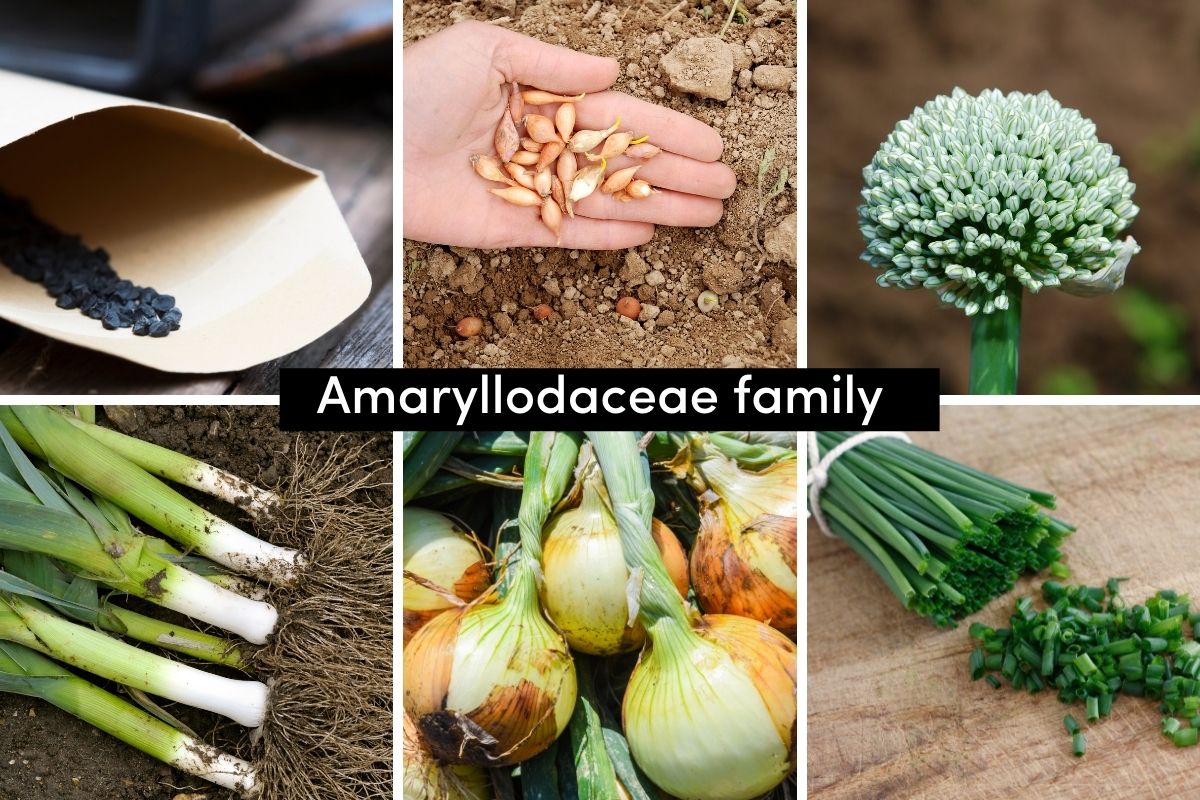
2. Brassicaceae (Brassica or Cabbage Family)
The brassica or cabbage family possibly boasts the widest variety of edible species. The list of common brassicas includes broccoli, Brussels sprouts, cabbage, cauliflower, collards, kale, mustard, radish and many more.
The majority of today's best-known brassica examples are cultivated descendants of a single wild cabbage ancestor, although others in the mustard group have their own heritage within the wider brassica family.
You may also see various brassicas described as members of the cruciferae family, thanks to their flowers with four petals shaped in a cross.
In gardening terms, most brassicas are heavy feeders and require a rich supply of both nutrients and water. They're usually cool-weather plants, with varying levels of frost tolerance but a tendency to bolt in hotter weather.
Brassica seeds are small and spherical, mostly brown or dark brown, and grow in pods. However, most homegrown brassicas are harvested before the pods have a chance to form.
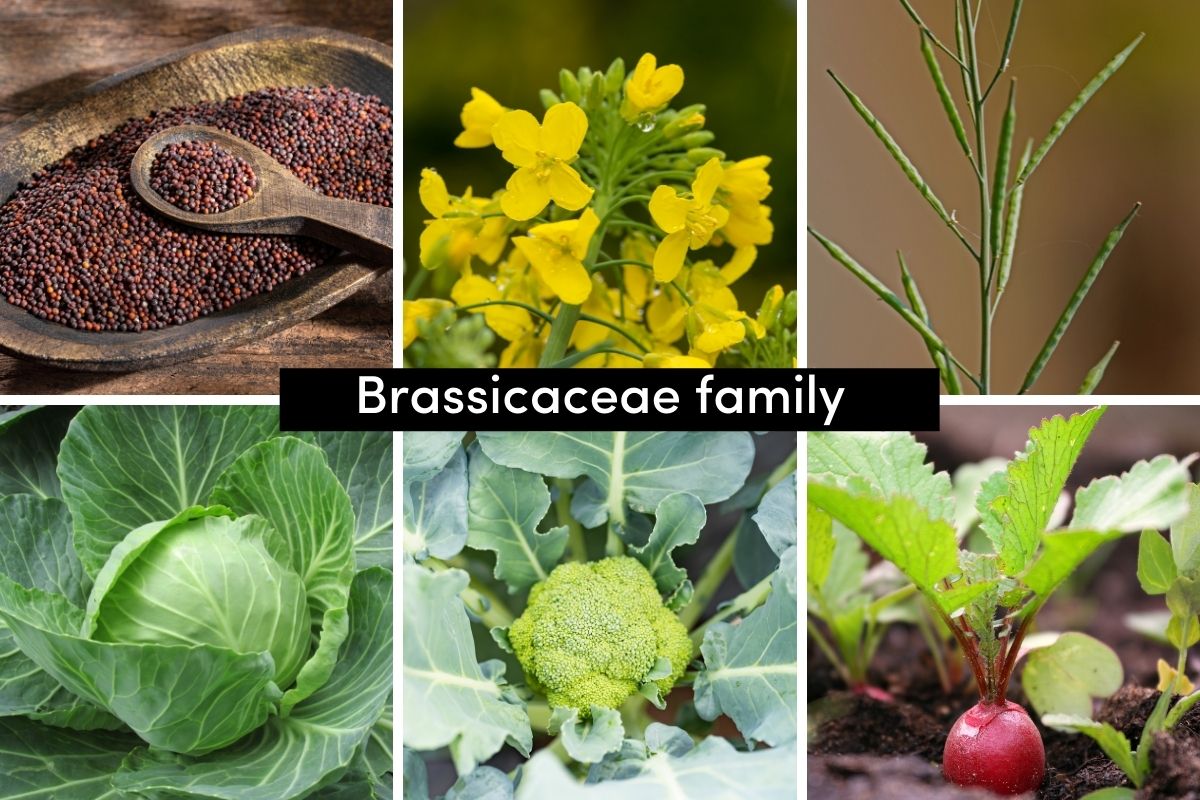
3. Cucurbitaceae (Squash or Gourd Family)
The cucurbit or squash family neatly straddles the boundary of what we call fruits and vegetables in an everyday sense. Common members include zucchini, pumpkins, and summer and winter squash, which most people would class as veggies. But the family also includes melons, more commonly considered a fruit, as well as cucumbers which lie somewhere in between.
What these species have in common is that they love heat and hate frost. They grow vigorously, mostly on vines but sometimes in bush form, and usually produce large, succulent leaves along with dramatic yellow-orange flowers in both male and female varieties. Their vigorous growth means they need plenty of water, plenty of feeding, and plenty of space to thrive.
The seeds of this family are distinctively large, flat, and pointed at one end, ranging in colour from black to pale yellow.
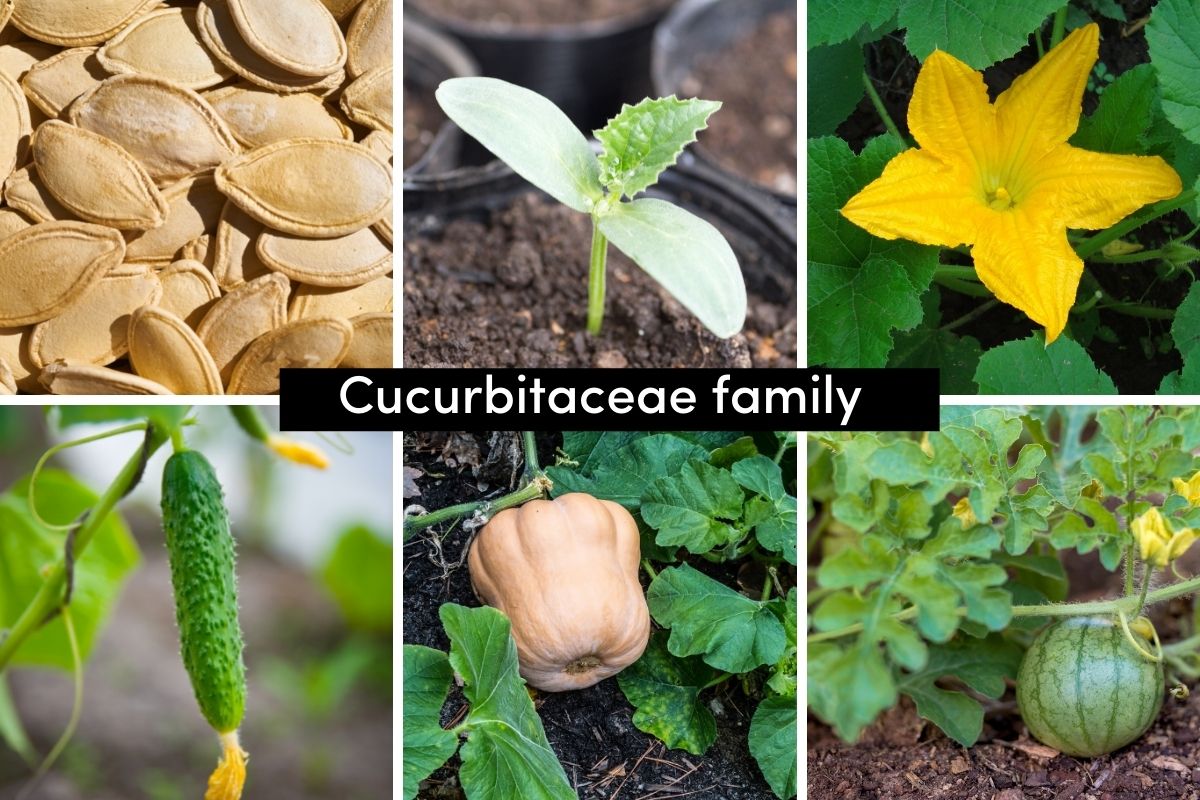
4. Fabaceae (Legume or Pea Family)
For the veggie gardener, the fabaceae or legume family is dominated by peas and beans, although lentils are also classed within the same group. The most visually obvious characteristic of legumes is their large round or oval seeds which grow several to a pod.
Legumes can grow as either climbing plants or squat bushes, with quite a lot of overlap between the two forms. For example, dwarf beans may grow in a bush-like shape but benefit from at least some support, while most climbing bean varieties definitely require canes or a trellis to twine themselves up around.
Legumes can grow in a fairly wide range of temperatures, but bean varieties are usually heat lovers, while peas are generally more hardy and prefer cooler conditions.
And lastly, legumes are noted for their ability to fix nitrogen in the soil as they grow. This makes them ideal to grow before brassicas in a crop rotation scheme, or simply as a green manure crop to refresh soil that would otherwise be unused.
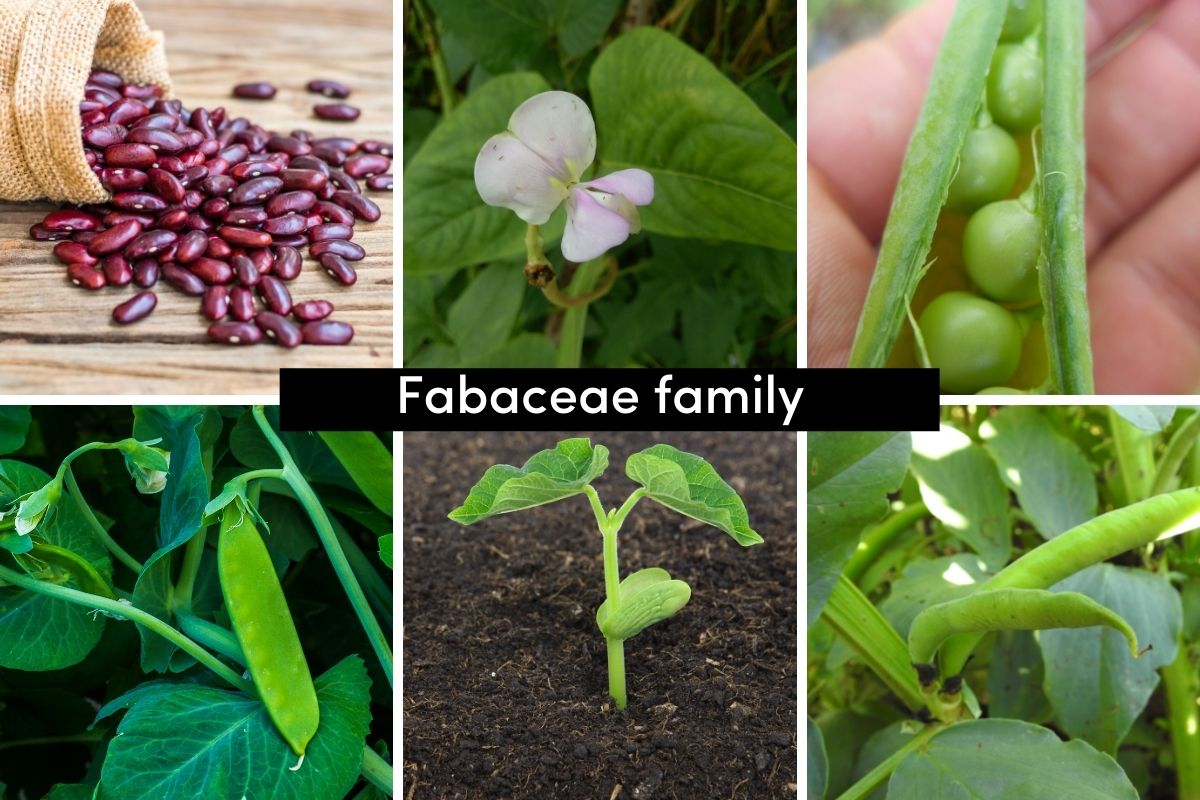
5. Solanaceae (Nightshade Family)
The last major family is technically known as solanaceae, or more commonly as nightshade. It contains some very familiar plants which most people may be surprised to discover are related.
Tomatoes, capsicums, chillies and eggplant are all included, and share a love for heat and a hatred of frost. Given the right conditions of warmth, water and copious nutrients they're fast-growing and productive, bearing five-petalled flowers followed by fruits containing flat, rounded seeds which are usually light in colour.
However, one outlier in the nightshade family is the potato. Not only is it hardier than its cousins, but it's also most often grown from seed potatoes rather than actual seed, to ensure the plants stay true to their variety.
Many members of the wider, non-veggie nightshade family are dangerously toxic. Some of the same poisons are found in the foliage of edible species, although at much lower levels. Because of this, even with edible nightshade plants, only the fruits should be eaten.
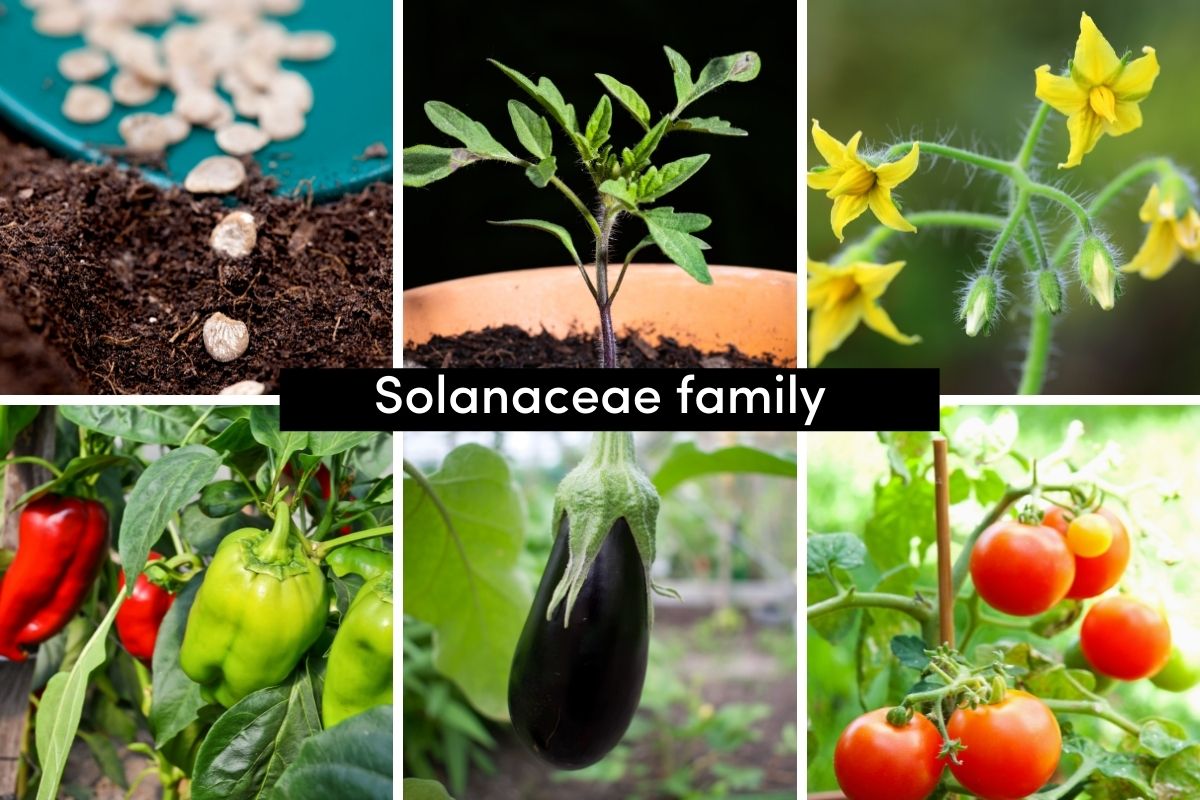
Other Well-Known Veggie Families
There are a few other plant families that most veggie gardeners will come across. Here are brief details of the most common ones.
a. Apiaceae (Umbel Family)
- Includes parsley, carrot, celery and fennel.
- The flowers are arranged in clusters, or umbels, which are magnets for bees and butterflies. However, most of the plants are harvested before flowers form unless you're specifically growing them for seed.
- Umbel seeds are long, thin, small, and light, and are sown either on the soil's surface or only a few millimetres below.
b. Poaceae (Grass Family)
- Includes major cereals and minor grains, such as corn, barley, oats, rice and millet.
- Some varieties such as maize have been bred to bear large fruits, although technically they're still grasses.
- For all edible grasses, it's the seeds which are eaten rather than the foliage.
c. Chenopodiaceae (Beet Family)
- As well as regular beetroot and silverbeet, this family also includes spinach.
- Beet family members are characterised by leafy plants that grow from the base.
- The leafy foliage means they're heavy feeders, with a particular need for nitrogen.
- It's most common to eat the roots of beets or the leaves of spinach, although the tops of beets can also be treated as spinach in many cases.
d. Asteraceae (Daisy family)
- Edible members of this diverse family include lettuce, chicory, burdock and artichoke.
- This family is characterised by its familiar daisy flowers, although many edible members of this family are harvested before the flowerheads form
- It’s most common to eat the leaves (lettuce, chicory), however the roots are also eaten (Burdock, Jerusalem artichoke) as are the flower buds (Globe Artichoke).
There are, of course, many more plant families out there to explore than the ones mentioned here. But grow at least one member of each of these families, and you'll have the experience to succeed with almost any common vegetable you decide to try in the future.





